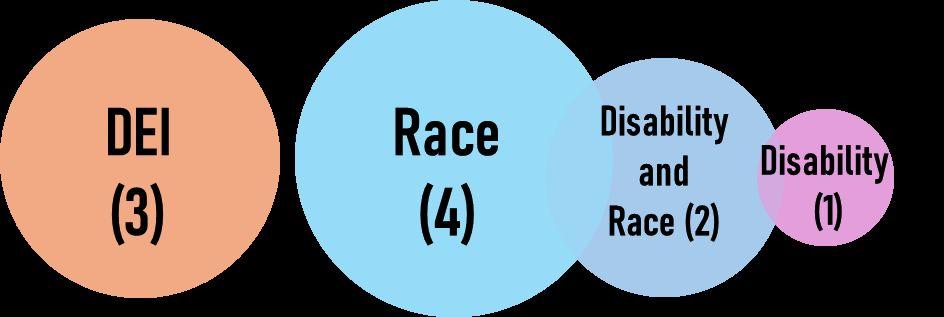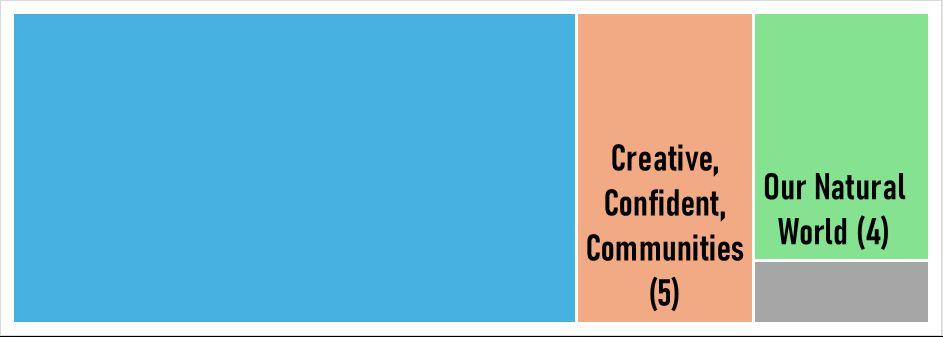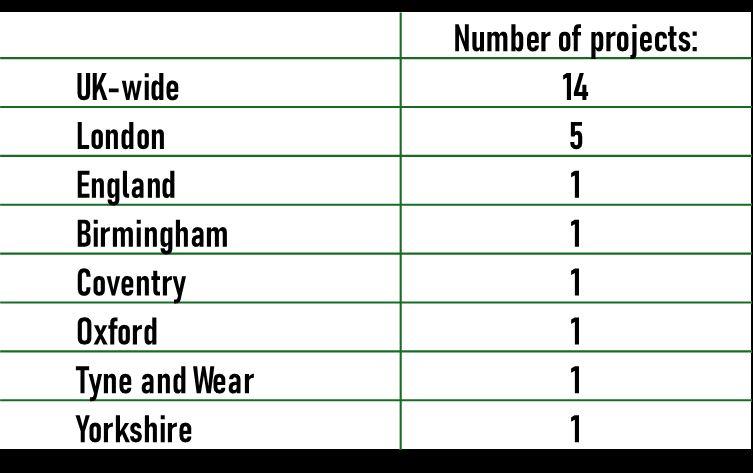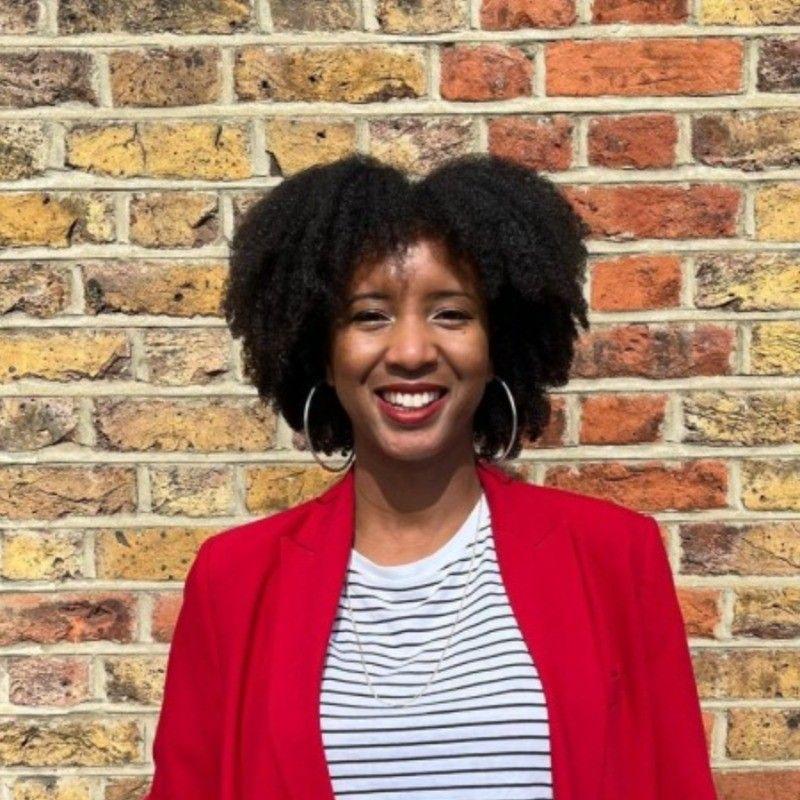

A review of Esmée Fairbairn Foundation’s Funding Plus support for Diversity, Equity
and Inclusion
June 2025



Context and Summary

Context | Executive summary
While funders exist to support organisations, the funding landscape creates complex power dynamics among and between funders, organisations, staff and users. This dynamic can influence feedback delivery in impact reports.
This review aims to help Esmée Fairbairn Foundation get a clearer picture.
About
Esmée Fairbairn Foundation
Founded in 1961, Esmée Fairbairn Foundation is one of the UK’s largest independent funders. In 2024, Esmée provided £48.8m in funding towards a wide range of work in support of its three main aims: to improve Our Natural World, secure AFairer Future and nurture Creative, Confident Communities. Esmée also has a £60m allocation to social investments and a £10m allocation to impact investments. Esmée’s funds are generated by its investment portfolio.
Funding Plus
Funding Plus is funding for capacity building provided to organisations Esmée funds to help them achieve greater impact. It is a responsive demand-led fund that enables organisations to make the most of opportunities, and to receive support they might not otherwise be able to afford or prioritise. Funded organisations can apply for money to commission tailored training, mental health and wellbeing support, strategy and organisational development, and communications consultancy. Esmée does not have a preferred supplier list.This allows organisations to choose a provider and approach that best suits their needs and circumstances. More information about Funding Plus is here.
Review Brief
Purpose
In 2020, diversity, equity and inclusion (DEI) support was specified in the Funding Plus offer after receiving more requests in response to the growing awareness of organisations to examine bias, discrimination, and systemic behaviours. So far, 26 organisations have used Funding Plus towards this work, of which 22 were expected to complete their projects by the end of 2024.
Approaches to DEI work chosen by organisations vary widely depending on specific needs and circumstances, as do delivery methods and costs of the support.As DEI practice continues to evolve, Esmée asked us to review the support commissioned by organisations through Funding Plus, including:
●Why the DEI approach was chosen
●What worked, in what circumstances, and for whom
●What organisations would do differently with hindsight
●Where organisations are now on their DEI journeys, and support outcomes
●What the organisations think Esmée, and other funders, could do to continue to support DEI work

Review Brief
Audience and use
Esmée wants to use the Review to:
●Understand the pros and cons of the different approaches to DEI – what works and what doesn't, in what circumstances – so that Esmée can better advise funded organisations.
● Understand what organisations think Esmée, and other funders, could do to continue to support DEI work.
● Help shape Esmée’s internal DEI work and progress internal DEI commitments.
●Esmée also wants to share the key findings with organisations it funds, other funders, and the wider sector.
Terms used
Throughout this report, we use DEI to refer to Diversity, Equity, and Inclusion. Other terms such as EDI (for Equity, Diversity, and Inclusion) have also been used where participants in the research have used them. You can see Esmée’s definition of Diversity, Equity, and Inclusion here.
People of Colour (POC) has been used to describe people who are not white.

About the Projects
Research involvement of 26 projects:

Area of Esmée’s strategy:

DEI focus for interviewed projects:

Where the projects work:




Meet the Team

researcher,Theresa works on justice, equity, and inclusion research delivering cultural insights, shaping healthcare and community strategies.

Amira supports charities in advancing justice, equity, and inclusion. She specialises in participatory methods, ensuring insights lead to meaningful change.

Tas combines organisational psychology and lived experience across research, consultancy, facilitation, and coaching, generating insights that advance equity and support relational change.

Amira Tharani
Theresa Jones Taslim Tharani
Executive Summary
DEI-specific funding was highly valued by organisations. This could be further supplemented by peer learning.
Key themes
● Avariation of DEI journeys means a variation of start points and growth areas.
● Partnerships shape practice: Providers often fostered atmospheres of safety and curiosity, which informed the project progression.
● Turning theory into practice takes time:There is no ‘cookie cutter’approach to DEI growth
● Main areas of advice: a clear ask (to organisations starting a Funding Plus journey), longer-term support (to funders).
● What’s working and what’s next for Esmée’s Funding Plus support: Flexibility is valued; a next step could be fostering peer learning.

Key themes in more detail
Avariation of DEI journeys Partnerships shape practice Turning theory into practice takes time What’s working and what’s next?
●There are varied start points as well as varying needs and capacities.
● Tailored support is key for aligning DEI efforts with specific goals.
● Arelational, learning culture leads to deeper, long-term impact.
●DEI should be integrated across all areas, not just HR.
●DEI provider characteristics were also important.
● Building safety, adding structure and rebalancing power were seen by our interviewees as particularly transformational for organisational DEI.
●Progress depends on building a shared language and embedding practical action.
●This process is often constrained by short-term, project-based funding, limiting space for strategic planning or organisational development.
●Esmée’s Funding Plus is well-placed to support DEI capacity-building.
●Flexible, light-touch support is valued by organisations.
●Safe, open spaces are key for progress.
●Many organisations have called for peer learning opportunities to strengthen impact.

Recommendations: for funders supporting organisational DEI journeys
Follow-ups are vital
●This was the most common ask
●Longer-term programmes to keep momentum
●Tailored support for Senior LeadershipTeams to drive culture change
●Additional funding for refresher training
●Periodic follow-up sessions to capture growth
Shift the landscape
●This was another top priority for organisations
● Set expectations for funding and evaluation criteria (i.e. racial equity) beyond funding
● Diversify support to make it more accessible (such as training, peer learning, and resource sharing)
●Offer DEI support alongside grant funding, so organisations don’t have to apply for it separately
●Offer more unrestricted funding
Facilitate peer learning
● Facilitate shared learning between organisations for DEI support and wider operational tools
●Consider creating content such as webinars and events to sustain focus

Recommendations: for organisations seeking DEI support
Be honest Make a plan
…about where you are on the journey and what the key next steps are for your organisation - then choose a provider to match.
Confidence is key
…for maintaining momentum after the support concludes and identify additional resources available at that stage.
…Leading this internal work is complex - it’s key to have someone with confidence to lead and the trust of the organisation (it may not always be the CEO)

Questions for further exploration by organisations, providers, and funders
Across the research, these questions were raised either directly in interviews or indirectly through the analysis.
➔ What is the right balance of theoretical knowledge, personal transformation and organisational action needed to embed meaningful DEI in organisations?
➔ How can charities and funders prioritise longer-term strategic approaches to DEI and broader organisational development so that charities can carry out their missions more effectively?
➔ How can organisational readiness for different types of DEI support be best assessed and organisations signposted to the right kind of support?


Methodology

Review at a Glance | Who We Heard From
Review at a Glance
1. Launch
research
Review of existing materials (inc. Funding Plus bids, and impact reports). Amix of semi-structured interviews and written evaluations. Presenting initial insights and agreeing on next steps. Report write-up and presentation, internal and external sharing. Align on Review goals, expectations, and ways of working.
Who We Heard From
We had a range of feedback across the 26 grantees
Semi-structured interviews across 10 organisations
● 10 organisations, 2 interviews per organisation (20 interviews in total).
Interviews
● 14/19 were directly involved in the DEI projects in their organisations.The other interviewees may have joined after the project finished or had less direct involvement.
● Most of the findings in this report are based on the 10 organisations we interviewed.
● Quotes in this report have been lightly edited for clarity.
An
optional mini-evaluation form
Feedback
Reports
● Organisations we didn’t interview were given the opportunity to share their post-project reflections, with 5 organisations sharing feedback through the form.
● These were used to supplement our overall findings.
Impact reports from all 26 organisations
● We used these for context-building and framing our discussions.
● We also looked at the bids from each organisation and provider CVs.
● These gave us further insight on organisational journeys.
Who We Heard From
Some
key perspectives aren’t fully reflected in this report, as we were not always able to interview junior members of staff, many people of colour or disabled people.
The majority of interviewees were:
● Senior staff, across:
○ Executive teams
○ Senior leadership
○ Senior management
● White staff members
● Non-disabled staff members
While there was a range of experiences, varied age and a fairly even gender split, we saw less racial diversity and we heard from fewer junior or operational members of staff across organisations. Commonly, POC and minoritised groups are more likely to be in less well-paid and secure work (in an already under-paid sector).This is likely to mean that the findings do not take full account of the impact of organisational DEI work on those staff most likely to be directly affected by it.

Funded Projects

Starting the Work | Experiences of Support | Enablers and Barriers
Starting the work
Key Takeaways
● Race and disability were the most common DEI focus areas.
● Training and strategy support were equally sought after.
● DEI drivers varied: race-focused work was often linked to external events, while disability work was driven by internal needs.
● Resource gaps remained a barrier, even for well-established organisations.
● No single DEI path: organisations had diverse starting points and support needs.

Themes and approaches
As the approaches sought were so varied, there is no singular measure of DEI success
● In our interview sample of 10, race and disability were the two most requested thematic areas, while 3/10 organisations requested general DEI support.
● Half our interview sample requested training delivery, while the other half sought strategy support, action planning or consultancy.
● All the organisations seeking generic DEI support opted for overall strategy, audits or action plans rather than training.Those that sought thematic support tended to opt for either a combination of training delivery and audit/consultancy or just training delivery.
A variety of DEI starting points mean equally varied DEI journeys
Most organisations were responding to specific needs either internally or externally
● Afew organisations were clear about addressing a single specific need, coming out of their staff’s direct experience at the organisation.These were also smaller and less well-funded organisations.
● Afew recognised that they were less diverse than the communities that they directly served and were keen to address this.
● The organisations that focused on DEI strategy development or more generic training often had an initial commitment to DEI but were not sure where to start or what actions to commit to.
● Some organisations referenced wider cultural moments in relation to racism - George Floyd’s murder, BLM and the Sewell Report, either as reasons to focus specifically on anti-racism or more generally on DEI.
● By contrast, organisations who focused on disability did not refer to external events.They were more likely to be driven by internal needs - either the needs of staff or of the communities that they served.
● Some organisations - especially those funded byA Fairer Future - had DEI-centred core missions and strong competence in those areas.They were generally looking to address intersectionality as it related to their core missions as they could see gaps in their approach to intersectionality.
● Lack of resource had previously been a barrier, for both small and large organisations.
● Several organisations in our sample had experienced rapid growth and therefore a need to set up more robust systems. We heard from organisations who wanted to bring people together post-Covid.
Experiences of Support
Key Takeaways
● Long-term engagement was key: Most organisations worked with providers over several months, combining training and consultancy.
● Three enablers to success: Organisational DEI commitment, skilled providers, clear project vision.
● Provider selection was critical: Organisations sought trusted, recommended, or highly specialised providers
● Safety and structure drove impact: Effective providers built trust, encouraged accountability, and tailored support to internal needs.
● Clarity reduced barriers: Organisations with a clear DEI vision and leadership buy-in saw the best outcomes; capacity and misalignment were common challenges.

How organisations engaged with DEI support
Most organisations worked with providers over several months, rather than one-off engagements. And all engagements were bespoke to the organisation’s needs.
● The majority of organisations in the interview sample opted for a combination of training and consultancy, with activities including:
○ Audits or surveys
○ Training workshops with staff
○ Coaching or support for staff members with specific DEI responsibilities
○ Development or co-development of action plans
● Afew organisations focused on training delivery for staff on specific issues that were emerging internally. In those cases, training was at least partially co-developed between the organisation and the provider.
● In one example, Funding Plus support was used to provide training to its delivery partners on a specific project, with some training for internal staff.
● Elsewhere, a portion of the Funding Plus support was used to pay for research conducted by a staff member at the organisation, including remuneration for community organisations participating in the research.
● Another approach was to use the funding to co-produce new approaches with Disabled creatives and accessibility specialists.
Choosing a provider
Choosing the right provider that met the specific needs of the organisation felt critical to many - and one size doesn’t fit all
● Choosing a provider wasn’t easy, but most provider relationships were successful.
● Within our interview sample of 10 organisations, most worked with their providers over several months and undertook a range of different activities.
● Half the organisations chose a provider either known to the organisation or recommended by one particular staff member in the organisation.
● Afew organisations conducted tender processes - two formal, one informal.
● Asmall number mentioned relying on Esmée’s provider list as they had struggled to find suitable providers.
● Asmall number of organisations commissioned specific training sessions.Although one-off sessions, the provider worked with the organisation to understand their needs and receive input into training design before session delivery.
● Elsewhere, we heard about choosing a provider as a ‘leap of faith’- conveying a sense of risk, even where the provider relationship worked out well and the provider had come recommended by a staff member.This was echoed in other interviews, if not in the same words.
● Organisations that were advanced in their journey and looking for nuanced expertise found it hard to find the specific expertise they sought.
Enablers
3 key enablers facilitated project implementation and impact.
Provider skill, sensitivity and knowledge of the organisation.
They were described as setting the tone for the projects and how they were implemented, felt, and embedded within organisations.
Enablers
Organisational DEI commitment and relational learning culture
Clear vision and parameters for the project
Organisation-provider relationships
The most transformational factors were building safety, adding structure and rebalancing power
Across the organisations we interviewed, they valued DEI support providers who provided them with:
● Safety-building
● Structure
● Aspace to reflect before applying practice
● Active ownership of the journey
They achieved this in various ways, including:
● Encouraging accountability among leadership
● Engaging with staff at all levels
● Rebalancing power dynamics in discussions
● Building credibility for DEI work internally
● Using their own past journey (if same sector)
● Demonstrating a sharp understanding of the organisation’s internal needs
○ While this would be standard practice in audit/strategy/consultancy provision, training providers also took the time to understand the organisation and tailor the training. When they did so, the training was particularly effective.
Provider characteristics
The DEI support provider's role was often seen as integral to the effective delivery of DEI projects. The following were especially important in fostering internal alignment.
Safety-building
This takes time as it’s a vulnerable step, albeit a foundational one. Success facilitates theory to become embedded practice in organisations.
Flexibility
Demonstrating and encouraging a flexible approach welcomes in the complexity of this long-term work, a contrast to the short-term nature of the funding landscape.
Expertise
Especially true for organisations who are further ahead in their DEI journeys. Finding a provider with a specialised focus topics helps them sharpen their DEI approaches.
“One thing that was good for us was that initial [trust-building]. I've heard about other situations where it's gone badly [and] there've been these big, open conversations that bring up a lot of pain and then leave people to crack on.You have to be wary of exposing Black and minoritised staff to the ignorance of their colleagues.”
- Interview 13
“I think it was good that there was a lot of acknowledgement [from our provider] to say:
‘Basically, this isn't the labor for the team, for Black and minority staff members to do - and you have expertise that we value - your experiences are welcomed if you would like to share them, but it's not your responsibility to share them’…. We can read the book. We can listen to our trainer. It's not on you.”
- Interview 13
Organisational culture
Organisational culture is a key enabler - especially when it was relational, reflective and committed to DEI work. Like the practitioner relationship, trust-building and safety are key factors.
Openness to dialogue
Building psychological safety welcomed transparency and curiosity. More advanced organisations were reflective about where the gaps were for them and how they could address them.
Visible leadership
Leadership that was both consistent and accountable set the tone for DEI practices to flourish internally and feel like ‘business as usual’rather than an ‘add-on’.
Committed to DEI
Astrong organisational commitment means that DEI work can progress without the extra effort and distraction of needing to justify it.
“We've got a colleague who runs our race Community of Practice, and the team set the space up so beautifully.They started with: ‘Don't talk as if you're representing an entire group, it's okay to ask questions, don't judge.’...Because it can feel really tricky for everyone coming into the space to talk about your experience or talk about your ignorance and not wanting to hurt or insult…[It’s] the way they set up those principles for how sensitive and traumatising or hard these conversations are in organisations.”
- Interview 4
“We are very articulate in the things we do on an organisational level, on an individual level as employees and on a systemic level. ..There’s such a complexity in looking at what prevents people participating in culture that I think it’s still really important to look at access and inclusion across the whole spectrum.”
- Interview 11
“There’s a culture of transparency, sharing and collaboration over competition. We’re aware of [structural barriers] and always share opportunities.”
- Interview 12
Confidence and a clear ask
Knowing ‘where you are on the journey’ is a crucial first step to getting the right DEI support. The clearer organisations were on their specific DEI needs, the more effective the DEI support was.
However, sometimes they needed support to achieve that clarity
● The organisations who knew what they wanted found it easier to work effectively with providers and generally felt more positive about project outcomes.
● Having a confident decision-maker lead the work was key - often from the leadership team, though not always the CEO.
○ It was helpful to have support from a project manager to keep momentum for delivery, especially if the work was led by the CEO, to allow them to balance broader strategic priorities.
● Although it was a difficult step for most, being honest about where they were on the DEI journey was often helpful in deciding on the right actions to take.
● Some providers used readiness frameworks to help organisations to be clear about where they were on the journey and what they were to do next, and this was found to be especially helpful.
Barriers
A mix of internal and external barriers added challenges to the DEI support journey. Most were overcome, but leadership buy-in and misalignment were harder to resolve.
While organisations appreciated the support, there were factors that made implementation more difficult.
● Capacity and conflicting commitments were the most frequently cited challenges. Organisations struggled with capacity to engage in the work. However, many found innovative ways to make training or workshops accessible, for example by closing the organisation for a day, releasing staff from other commitments or holding training in-person.
● Leadership buy-in: Strong leadership buy-in was common. Where that wasn’t the case, it was much harder to ensure that the funding was spent on what it was intended for, and to embed the work across the organisation.
● Misalignment: Generally, this was internal, either between teams or with leadership or trustee boards. In one case miscommunication with the provider led to faulty assumptions on both sides and barriers to project progress.
● Fear: We heard about a fear of ‘getting it wrong’and letting down minoritised communities. We heard how developing a shared language enabled an organisation to work through this to start being bolder about its communications and commitments.
“There's perhaps also a bit of a lack of confidence, I guess, to to push things forwards…not wanting to get it wrong…We have had criticism in the past from Black-led groups, because we’ve been able to get funding to work with Black and minority ethnic groups. We’ve had people say ‘should you be able to get the funding because you’re not from those communities?’and we don’t want to get this wrong because the intention is in the right place, but how do you do that in a way that’s also open and honest about where we are?”
- Interview 18
After the project

Project Outcomes | Embedding the Support
Project Outcomes
Key Takeaways
● Successful DEI work isn’t a one-size-fits-all approachthere are multiple layers of complexity
● Varied starting points means varied project outcomes
● We identified these outcomes across 5 levels
● These outcomes have implications for individuals, teams, organisational culture and projects they work on

What does DEI success look like?
We heard from organisations that it’s not ‘just a tick-box’ approach. They are looking for deep cultural change, not surface-level interventions.
They acknowledge the complexity of the work and the need for sustainability
● For some organisations, it was important that DEI was embedded not just in their internal processes and staffing but also in their project work, strategy and impact.This was especially the case for organisations which worked directly with minoritised communities.
● There was a sense from some organisations that DEI should translate into all staff feeling heard, valued and able to thrive - perhaps especially for those organisations whose DEI work had come about because of things staff were directly experiencing.
● Several organisations said that the DEI journey is ongoing and never ‘done’- there is a need for constant self-reflection.
DEI success in their words…
"It's not just about celebrating the 7/10 who are in the room... It's also about questioning why the 3/10 aren't there"
- Interview 7
“Every time we're doing something, when we need to be thinking about these things and it needs to be part of the culture, not one person constantly nagging about it”
- Interview 1
“[DEI is successful when] it’s at the core of what you do - it’s not a policy, it’s not an action plan, it’s… the workplace culture you create on a daily basis”
- Interview 11
“Having our staff demographics more closely correlate with the communities we’re working with, so that work is better informed by their needs rather than what we think is the right thing to do”
- Interview 2
“You can do all you want with recruitment and representation but if the impact of your EDI work [on the communities you serve] isn’t transformative, it isn’t going to go anywhere.”
- Interview 10
Overview of project outcomes at five levels
DEI support can lead to outcomes at different levels, depending on the organisation’s starting point, internal culture and nature of support provided
Personal learning & transformation
New theoretical frameworks and deeper changes to mental models, approaches, relationships or emotions
Action planning & strategy Developing a plan for next steps
Staff experience & demographics
Either changes in the experience of minoritised staff, or changes in the composition of staff, volunteers or trustees - and sometimes both
Changes to project delivery
Embedding DEI learning in the delivery of services, partnerships and/or communications
Impact at strategic/ organisational level
Organisational transformation in terms of strategy or overall culture
Project Outcomes
1. Personal learning
Without changing mental models it is difficult, if not impossible, to embed structural change.
Several interviewees referenced that their own or other staff members’personal learning was a key outcome of the project.
● This was usually the case if training or workshops were involved, but also came up in some of the consultancy projects.
○ In one example, workshops focused on developing and sharing personal stories - this was found to be deeply transformative for colleagues who participated.The personal, story-based nature of the workshops created the space for re-framing themes of belonging and not belonging.
● Frameworks and models were often described as effective (eg social model of disability, 5 ‘I’s of oppression).
● Personal transformation is the most effective starting point for organisational and institutional transformation.
● In cases where learning was limited to the individual (for example, if the organisational culture was less supportive or wider embedding of DEI learning wasn’t sustained) the individuals we spoke to were still able to use what they learned in their own work.
Project Outcomes
Their personal learning journeys...
I learned a lot that I use on all my projects now pretty much as basic principles [around engagement and safety-building]”
- Interview 2
“There was a guy in our group who said ‘I can’t believe that there are people who feel [excluded] like I did in this situation - that they feel that way about nature.’And we all felt it through his eyes - he felt it really deeply.”
- Interview 20
“I learned a huge amount actually, from the reflections of the white women, their experience of anti-racism and what they was thinking about. So I felt like maybe they put themselves on the line, and taking a lot more risk to be open and vulnerable than they otherwise might have done.And I really appreciated that.”
- Interview 14
“I think we know from conversations with staff that it's just opened their eyes [to different] ways of thinking and understanding of what somebody might have been through and how things might impact them.”
- Interview 15
Developing a shared language was an enabler of developing meaningful action planning and strategy
Some organisations who sought support with action planning and strategy came away with action plans they could use and implement
● For some organisations, having clear action plans and more structure to the DEI approach moved DEI away from something that was just one person’s passion and into something the organisation reviewed strategically. It was subsequently built into areas such as job roles, objectives and organisational strategies.
2. Action planning and strategy Project Outcomes
● Some organisations struggled to develop and implement actions
○ In one example, the transition from personal transformation to action and strategy was dependent on the CEO driving it and workload pressures meant that there was limited follow-up.
○ In another, the focus of workshops was primarily on personal transformation and deep change. Some within the organisation wanted to move to action earlier - which led to some challenges with the provider. Others saw the rush to action as a possible indicator of white supremacy culture.
What we heard about action planning and strategy…
“We were having really interesting conversations, light bulb moments, but I needed to know what we were going to do with what we were learning.”
- Interview 3
“Rushing to action is a symptom of white supremacy, and the fact that you think you have the answers and you can solve things is almost like part of the structure of institutional racism”
- Interview 4
“So our next 3 year strategy and EDI is already one of the enabling change goals that we've identified that will underpin our priorities.”
- Interview 9
“We have like five targets, and one of them is about organisational health, and that is, ‘What are you doing on anti racism?’We've got these kind of regular review slots for progress”
- Interview 13
3. Impact on staff experience/diversity
Demographic changes - especially in leadership - further enables embedding of DEI in organisations.
Few demographic shifts, but some key changes in the experience of racially minoritised staff:
● Very few organisations have seen demographic shifts at this stage, although there have been some, such as a woman of colour joining a senior leadership team, and more Black men joining an organisation.
● One organisation which focused its DEI provision strongly on accommodating staff with particular needs was able to embed this provision into management practice across the organisation.
● Elsewhere, we heard about how a combination of sector-wide training initiative and updated recruitment strategies was a way forward. However, due to low turnover, this has not yet been translated into more organisational diversity.
● There have been some shifts in the experience of minoritised staff in some organisations:
○ In some organisations, staff from all backgrounds have felt more confident and able to have conversations about race and racism.
○ In one example, staff from minoritised backgrounds (and in roles where they were more likely to experience direct racism from visitors) felt more heard and valued by the organisation.
○ In another example, staff have begun disclosing access needs and seeing them being met.
Project Outcomes
Impact on staff in their words…
“We've had a sharp increase in number of staff members who are disclosing access needs, going through processes to bring in occupational therapists andAccess to Work as well.”
- Interview 8
“It's about having that conversation about, what is it you need from us to be your best? What is it that you need us to do to enable you to function within the workplace? But it's all very, very individually based. So there's no just because you're autistic, X,Yand Z happens.”
- Interview 16
“When they were interviewing [for my role in the senior leadership team] it was a much more diverse pool of candidates.”
- Interview 9
“As a refugee and a person of colour, the world ‘tolerance’doesn’t sit well with me - and colleagues wanted to hear why that was the case, because for them it wasn’t as charged - it was nice to have those conversations.”
- Interview 6
4. Impact on delivery of work
Organisations wanted to see impact on project delivery, not just internal staff experience
Several organisations had linked their DEI work to project delivery - and even where they had not, it often had an impact on project design and delivery, especially if the organisation worked with minoritised communities.
● Several organisations found that the DEI work - whether training or strategic consultancy - had an impact on the design and delivery of projects.This included:
○ Building anti-racism directly into the design of a new project for which the organisation is seeking funding.
○ Creating a manual for practitioners working with young people from minoritised groups.
○ Having more direct and focused external communications about race and racism (for example in the light of the riots).
○ Co-designing and co-producing new work with the affected communities, or building in community engagement into new or existing pieces of work.
Project Outcomes
Delivery impact in their words…
“[Anti-racism] is not the first thing in our minds because it’s not our [direct] experience. So we have to be properly conscious of it and constantly bring it in.”
- Interview 4
“Any time we make a funding application we include budget to work with by-and-for organisations - to recognise their contribution in terms of remuneration and also their expertise.”
- Interview 9
“So for instance, when the riots happened over the summer, I think that the team felt more comfortable having something to say about it than they might have, because we accepted that we are going to be vulnerable in this. People won't like it. Some people will say that we've done this wrong.And the biggest fear is that you'll let down Black women, minoritised women - that's the fear, right?”
- Interview 13
5. Impact at a strategic or organisational level
Where change was seen, it was often embedded in policies or manuals
It was difficult for DEI support to result in overall organisational transformation: progress was often patchy
● Even in smaller organisations, it was difficult to translate impacts in individual teams or projects to the organisational or strategic level, and this was even more strongly visible in the two larger organisations, where there was little strategic change. Progress was often patchy and limited to those teams or individuals who had had more direct contact with the providers.
● Demographic changes at senior level have been slow, and some interviewees suggested that this was a barrier to the transformative and structural changes that they had hoped for.
● Asmall number of organisations found that their trustee boards had been able to provide more helpful and constructive challenge. In one example, this was partly because the makeup of the board had been refreshed.
● Several organisations did talk about the support resulting in more structured, systematic or strategic approaches to DEI and were beginning to see the signs of this becoming more embedded. In some organisations, this translated into HR policy reviews, updated recruitment strategies or manuals for delivering more inclusive project work.
Project Outcomes
Organisational impact in their words..
“It’s like pockets of practice, which makes it really hard to [achieve] consistency or standardisation. If we’ve been involved or have lived experience [there is more likely to be good practice].”
“We’ve been reviewing all of our governance policies and procedures over the last few years. Every time, we’ve said, ‘What’s the anti-racism lens on this?’For instance, our grievance policy, our complaints policy, and our working-from-home policy."
- Interview 4
“Until we get more leaders and people throughout an organisation who are women of colour, it’s always going to be a bit of an uphill struggle.”
- Interview 13
- Interview 14
Embedding the Support
The ripple effect of Funding Plus support has not impacted staff diversity, even amidst hiring strategies.

Some organisations feel the support helps them more meaningfully progress perceptions of DEI work from a HR issue to an organisationally strategic imperative.
The lack of diversity in the senior leadership team is felt to be a barrier to transformative and structural changes.
Embedding the support: barriers
Key Takeaways
● Most organisations struggled to maintain momentum after the support ended.This was the result of several internal and external barriers.
● The most common internal barriers tended to be: Lack of clarity for long term work, misalignment, DEI treated as a separate journey (rather than intrinsic to organisational strategy), and power and relational dynamics.
● The most common external barriers we heard about were funding and resourcing constraints.

Internal barriers to sustaining momentum
Various types of barriers led to different approaches (and outcomes)
Short-termism (the most common barrier):
● An unclear long term DEI plan impedes how embedded the support is across the whole organisation.
● Unstable foundations mean fire-fighting mode can take precedence over strategy, especially when knowledge is lost due to staff churn.
● The lack of a shared language is a blocker to foundational growth and transparent conversations, as is ‘fear of getting it wrong’.
“I think the challenge, the main challenge, is still people being given the time that's needed to spend on doing this properly. And so that's that's upskilling, and learning the skills that are needed, and then also the time that's required to consider EDI properly in project design and in implementation.”
Misalignment:
● Lack of cohesion - teams or partner organisations are in different places, and assumptions can lead to differing expectations - that may need additional management.
DEI as add-on:
● When it’s not seen as an intrinsic part of the business, it can become a battle, especially when there are differing perceptions between teams.
Power and relational dynamics:
● Leadership blind spots about what isn’t working and issues going unsaid by staff across levels hints at traces of fragility, which undermine the work.
Alignment with the board
This was sometimes hard to reconcile with the long-term mission. In some organisations, the board (and in others the executive leadership) was seen as a barrier to embedding DEI.
Perceptions seem to differ between ideal approaches to DEI:
● Some organisations indicated that they expected their board to drive DEI work more actively.
● Others felt that they were facing tangible pushback or lack of buy-in from them.
● Very few organisations talked about board management:
○ Afew highlighted the importance of framing
○ Semantics can block momentum and delay the process
● In one example, the executive leadership and their lack-of buy-in was named as a key barrier to embedding DEI work in the organisation.
● Sometimes organisations spend time bogged down in the bureaucracy of trying to get buy-in than progressing in the work.
● Organisations that are further along on their DEI journey tend to acknowledge contrasting views and find ways to adhere to their strategic vision.
“You can do the big awareness stuff, or even like changing a recruitment process. But how you do the whole behavior bit, and the inclusion bit? The deep work and the culture change.”
Interview 2
“A lot of that in the charity sector is down to not knowing how to manage their board, and you have to manage them. If you're not managing your board, they're gonna manage themselves.And you can lay awake and cry about the outcomes, but you're the CEO, that's your job. …You don't have to tell them. It's their duty to ask you. But if you want to do some EDI work, do some EDI work, you don't have to tell the board… For me, if it's just impact, [then] frame it as impact... I just don't think it's that deep.
But another thing is that when you make it deep, when you make it a big issue that [that your board] has become an anti racist board - why bother?All you need to do is get them to sign off on it - they don't need to become anti racist overnight. Have them gently accept that this is the standard, and this is this is the movement and the strategy of the organisation, but in line with best practice, in line with compliance. That's the only things that they're supposed to care about.”
- Interview 8
External barriers
Funding constraints led to short-termism. Without core or ring-fenced long-term funding, organisations will struggle to embed lasting change.
Funding/resourcing constraints
● Most of the organisations we spoke to found it difficult to sustain momentum once the funding had come to an end. While some had embedded DEI into strategy, they still found it challenging to sustain and resource further development.
● Charity sector funding is often short-term and project specific.This makes it challenging for organisations to invest in long-term organisational development and also increases staff turnover as staff are often on short-term contracts.
● Embedding change is therefore often more challenging in the charity sector.
“There are always so many competing priorities. And it's so difficult to make plans when you don't quite know what on earth is happening to your organisation in 6 months time.” Interview 5
In their words
“So all of our internal work on race action or comms or impact, they're funded so far as we can afford to do that.And actually, if our programmes and the tenders coming in don't focus on race equity, or pull our team who have capacity to do that away, then the work stops.”
“If you’ve got a lot of restricted funding, and funders are being more stringent about EDI requirements for funding bids, then you end up in a situation where the expectation on us is quite high and our capacity to meet it is constrained. Even developing meaningful actions to put in a bid is a piece of work someone needs to do.”
“As a charity with no building, one of our biggest overheads are salaries, and that makes it really difficult to find money, for research, especially where you want to remunerate people for their part in that research properly. So that continues to be a challenge.”
- Interview 9
- Interview 4
- Interview 19
“I see it as my job, and it has always been a part of my job to push back on chief executives and Finance Directors…And they know there is a purpose for this money. It is not just any money. We have to organise our activities around things that they are funded for and not things that are not funded for… It is the job of a fundraiser to delegate and defend the restrictions around particular types of funding, and particularly with something like [Funding Plus], the boundaries are fairly well set, and the system for saying ‘you can spend on this rather than that’are pretty clear and very helpful”
- Interview 7
Recommendations

Funding Plus: What’s next? |Advice to others
Funding Plus
Funding Plus is seen to offer invaluable support. Many appreciated Esmée’s light-touch reporting requirements and experiences have been positive across organisations.
There are key factors that Esmée does especially well:
● The value of Funding Plus for DEI and organisational investment is greatly felt.
● Many appreciate that Funding Plus exists to exclusively support DEI capacity-building that can otherwise get de-prioritised.
● Esmée’s flexible and supportive approach helped some sustain projects.
● Some feel that other funders could adopt a similar approach given the resource and time-intensive nature of the bidding process - or could even pool funds for DEI support.

“Esmee really helped us. It was that reactive, agile way of funding that the sector really needs.And they supported us. So it felt like we were working in partnership. I think what the Funding Plus does is absolutely excellent. I think it's excellent because it's light touch…Yes, you have to have a clear plan.You need to know what you want to do with it, but it's not taking up a huge amount of resource to access the funds, because it's incredibly specific. It works in a way that enables growth, and it enables growth in quite an organic way.”
- Interview 11
How can Funding Plus support for DEI be improved
Most suggestions focused on strengthening the sector. There’s also scope to create opportunities for organisations to share learning.
● Include Funding Plus case studies/hub to help organisations better understand the types of activities and approaches that have been successful.
● Provide more information about the providers and consultants used by other organisations to help streamline the process for those seeking similar support.
● Help build longer-term capacities in small organisations through collaborative and cost-effective models.
● Provide tools and resources to support ongoing DEI work, even after the funding period has ended.
● Convene opportunities for organisations to learn from each other.

“I think bringing people together at events. It certainly used to be more common. I think that post-Covid. I just don't know how many of these things happen anymore, but I've always found those sorts of things really useful to meet with other organisations and be able to put these topics together and have some expert speakers get inspired…It's also helping you to go into the process and then get more credit on, you know, where things might take a bit more time than you anticipated, especially around community building. It feels like it has so many benefits to it as well.And I think you can get inspired by people as well that might be a bit more radical than you are [and you can see that] ‘Oh, wow. Look, they're doing that. Come on, we should be doing more for sure’”
- Interview 18
Advice to Organisations
Managing expectations turn theory into practice and help to keep the long-term focus.
Anticipate delays in parts of the process
● Finding a provider, onboarding different teams, and identifying attendees took time and resource
DEI integration into organisational strategy
● Focusing on sustainability, using metrics, ensuring alignment of values (inc. provider)
● Having a plan for what happens after the support is crucial to keep momentum going once support finishes
Have an open approach to help build safety
● This looked like: addressing and rebalancing power dynamics, being flexible to unexpected outcomes, creating a culture of shared learning, being realistic about DEI work being a long term process, visible, confident leadership, and accountable engagement across the team
● Being honest about organisational readiness is crucial to finding the right provider and working with them effectively
● It was important to get the right balance between personal learning (which is deep and difficult work) and moving to organisational action
Starting the journey
Confidence and a clear vision are crucial. And having a shared language or theoretical framework helps, but moving to practice is key.
● Organisations who knew what they wanted found progressing DEI work was smoother: Transparency about where you are on the journey helps identify the key next steps for your organisation - and choosing a provider to match.
● This was a hard but helpful step - providers supported here.
● Some social justice-focused organisations were already further ahead, but needed support translating theory into action.
● Make a plan for maintaining momentum after the support ends and identify additional resources available at that stage.
● Leading this internal work is complex - it’s key to have someone with confidence to lead and the trust of the organisation (it may not always be the CEO).

Advice to Funders
Funders can help shift DEI progress within the charity sector. Flexible approaches are possible.
● Ensure that applications are light-touch and easy to complete.
● Use your convening role to facilitate shared learning among organisations committed to DEI.
● Consider pooled funds for DEI support with a single application form and reporting structure.
● Consider both long-term unrestricted funding and ring-fenced funding for organisational development.


Appendix
Experiences informing our approach
Reimagining Research
Acourse by design and research consultancy, Pause + Effect, challenging colonial research paradigms to foster equitable, reflective practices that centre care and meaningful dialogue between researchers and participants.
The work that Reconnects
Aset of practices for collective healing and action in relation to the climate crisis, meant for anyone who longs to serve the healing of our world in a more powerful and effective way.
Personal & Professional
We’ve worked with people across communities experiencing varying challenges in their intersectional identities. We bring our lived experience to this work.
The social model of disability
A shared understanding can be crucial for shifting approaches to disability in organisations.
Disabled people are disabled not by their impairment but by societal barriers to access
● In some organisations, the social model of disability radically reframed how they thought about disability and access within DEI.
● While the social model is commonplace in disability justice circles it is not well understood in the mainstream.
Inaccessible Infrastructure
Lack of Services
Poor Communication
“I think there is still in the workplace, a medical model of disability rather than a social model. And this training, and the time and space for these kind of conversations in a workplace helps us look at what that social model of disability is.”
Negative Stereotyping
Poor Understanding
Increased Social Isolation
Environmental
Societal barriers
Attitudinal
Institutional
Lack of Employment Opportunities
Non-Inclusive Legislation, Policies & Procedures
Lack of Educational Opportunities
The 5 I’s of oppression
This framework shows how oppression can appear at different levels
● Also commonly outlined as 4 I’s
● Those at earlier stages of the DEI journey are used to thinking of oppression primarily at the interpersonal level
● The 5 ‘I’s’helps to show that oppression can also be embedded at institutional and ideological levels
● We heard that this was especially helpful when encouraged to think of the ‘fifth I’: invisiblised oppression
Interpersonal Institutional Ideological Invisibilised
Internal
“I thought: ‘I'm a real advocate’, ‘I'm an ally’, and then you realise actually some of your behaviors are microaggressions, or they are actually damaging in a way…Recognising your own privilege and the way that you damage people of color in a way without realising it when you think you're doing good, or you don't realise it's a microaggression, and then recognising that because of white supremacy, you think you can solve things that maybe aren't even your space to do.”
This can support organisations to think more carefully about dismantling oppression at multiple levels.
White Supremacy Culture (WSC)
This framework was used in a few organisational journeys, often as a starting point for opening up a shared language
● The 15 characteristics of WSC were developed by Dr. Kenneth Jones &Tema Okun as part of their work on ‘Dismantling Racism:AWorkbook for Social Change Groups.’
● Context is important: many on their own are not always examples of WSC
○ It’s the overlapping factors that can contribute to a white supremacist culture, systems and policies
This highlights the importance of creating a shared language and understanding at the personal and organisational levels.
Perfectionism Sense of Urgency Defensiveness Quantity Over Quality Worship of the Written Word
Paternalism Either/Or Thinking Power Hoarding Fear of Open Conflict Individualism

www.luminanceinsight.co.uk

theresa@luminanceinsight.co.uk




